
 Minotels are excellent smaller, family-run properties. Find them at http://www.minotel.com Add your tiny tip here.  They are small - you might even say tiny. Twitter tiny - but in a real big blog. We wanted to write simple tips that would take only seconds to read. Comments are open on all T3: Tiny Travel Tips so please feel free to add your own tips! Tip # 1: Eating green apples helps prevent motion sickness. Add your tiny tip here.  Dall's Porpoise At 55 km/hr Off Juneau Back in the day when the earth was still cooling, I purchased my first "real" camera - a Pentax Spotmatic II. I paid the astronomical sum of $214 for it and, in spite of its name, it didn't have a spot meter in it. Thus I learned two valuable lessons - Pentax makes some great cameras and never believe marketing hype! Ever since, cameras have gained more and more complex features that have taken work away from the photographer. Today we use what amounts to a optical computer that needs to boot up, uncover/deploy the lens, determine which orientation the camera is in, establish what light sensitivity to use, recognize the size and format the final picture should be in, if there is a face that can be recognized, where the main subject is, what proper exposure to set and what shutter/aperture combination should be used. All of this happens, in some cases, in well under a second. Having done all this, the camera still needs to be told to focus on the subject, trip the shutter and write the image to the memory card. The space between pressing of the shutter and the final recording of the image is known as "shutter lag" and can be a frustratingly long period of time. Cameras.co.uk has a shuttle lag table that compares a number of cameras. The shuttler lag ranges from 0.18 to 1.68 seconds for a single image and 6.1 to 40.43 seconds for five images. This type of delay, especially at the long end, can be the difference between having more that one photo of a grandchild blowing out birthday candles or a speeding Dall's Porpoise that can travel at 55 km/hr. Old film cameras really were point and shoot (once you had adjusted the necessary settings on the camera) with instantaneous "writing" of an image to film. Today's cameras need to make these settings on the fly and it can really slow down the act of taking a picture. Photographers who want to gain precious time will "preload" the camera by pointing to where the action is (or will be) and softly pressing and holding the shutter release halfway. The camera will focus, charge the image sensor and perform any and all other calculations necessary to get the shot. When the action is just right, or when the subject enters the frame - press the shutter release all the way . The same technique can be used to prefocus on one part of the image and then recompose (move) the camera to get a better photo. This works well with portraits or landscapes where you may not want the subject in the centre. Point the camera directly at that large tree in the landscape (or at uncle Bill), gently press the shutter release part way, then continue to hold and recompose so that you subject is now in another part of the image. In essence, today's cameras are really "point, press and shoot" and if you can use them this way, you will eliminate some of the lag you may be experiencing in your camera. Has shutter lag ever "caught" you at a bad time? Feel free to share your pain in the comment box. 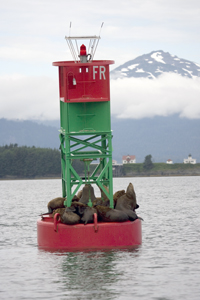 Point Retreat with Buoy and Sea Lions Alaska is a funny place. One day it can be so hot and sunny that you want to dive into your suitcase looking for your Hawaiian shirt and shorts. The next day you could be standing in front of a glacier in the pouring rain wondering why you left your parka at home. The secret, associated with most outdoor activities, is to dress in layers and have sympathy for your extremities as well. This flexibility is really important on an Alaskan cruise because bad weather is often good weather for photgraphers. Jan and I both take fleece vests or sweaters that zip up in the front and then a rainproof outer shell. This protects us in cold and wet conditions and allows us to wear the jacket or sweater separately should it not be as cold or wet. Remember, it may seem quite warm out on your balcony or on the promenade deck, but you may be in a protected area where you can't really gauge weather conditions. Out on a land or sea excursion you may find the weather more extreme than what you experienced on the ship. Jan also brings along a pair of chenille gloves and a headband. Both are small enough to put into a pocket and deploy only if necessary. I have a pair of LowePro gloves that are woven with little non-slip nubs on the fingers. These gloves are good for most of the conditions that Alaska can throw at you during the cruise season. I also take along a short-billed baseball cap (like the ones umpires wear) so that it doesn't interfere with my camera or lens. I used to wear a regular baseball cap backwards, but at my age it makes me look somewhat odd - like I can't dress myself in the morning odd. The trick is to be flexible and expect the weather to change. If you are out on a tour in the early morning you will have to dress more warmly than if you go out in the afternoon. It will probably be cooler if you are heading into the wilderness or onto the water than if you are staying in town shopping. Jan and I went hiking into the rain forest on a particularly warm day. As soon as we passed into the shade of the forest canopy, the temperature dropped significantly and it was great to have those layers of clothing to rely on. Finally, please remember that if the words "flight" or "heli" are in your tour description, chances are you are going somewhere cool - and I mean that in both senses of the word! Try the layered approach and remember, the cruise line will be happy to sell you clothing in the ship's stores if you have miscalculated on your wardrobe choices. 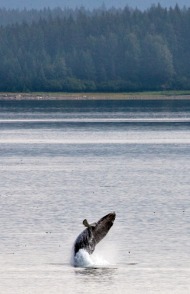 Breaching Whale Spotted From Balcony I usually waffle a bit answering the question "inside or outside" as this is a very personal choice. The whole ship is available to you regardless of the "class" of cabin you invest in, so it might not seem like an advantage to pony up for the extra cost of a balcony. Having said that, an Alaskan itinerary is one of those special trips where a balcony can be a real advantage. Because the scenery is so magnificent and the ship is often close to shore, passengers on Alaskan itineraries tend to be out and about on their balconies for hours. Yes, you can get the same view from any of the open decks, but there are times in the morning, late evening or even as you get ready for dinner that you can take a moment to step out on your balcony for a quick peek at the landscape slipping by. Whale, porpoise, seal or eagle spotting is a popular past time on board and it's great to be steps away for the chance to see these fascinating creatures. The picture to the left was taken in Glacier Bay, and from the balcony of our stateroom. It was pouring rain for most of the journey through Glacier Bay and we didn't want to stand on the open deck getting soaked. Instead, we ordered coffee and tea from room service and sipped our drinks beside the open balcony door. When anything interesting presented itself, we simply stepped out onto the balcony. If you are careful and cruise to Alaska in the spring or fall, you should be able to get a balcony for the cost of an inside cabin during the summer. So, I shall not waffle. If you're thinking about cruising to Alaska, consider a balcony - you will not be disappointed! 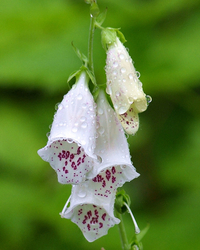 Alaska Flowers in Juneau With apologies to the two Johnny's - Horton and Cash - who sung "When It's Springtime in Alaska (It's Forty Below)", it is NOT forty below at this time of year. And the Red Dog Saloon is in Juneau, not Fairbanks, boys! Average temperatures in Juneau in May range from 40F overnight to 56F during the day. The record high in May is recorded at 80F. So, what does that mean for you if you're sailing to Alaska in spring? Just like summer and fall - dress in layers and be prepared for sunny and warm conditions as well as wet and cold conditions. No matter how warm it is or when you travel in Alaska, there are places where you'll need that extra sweater or jacket. You will never be warm enough as you stand in front of Hubbard or Mendenhall Glaciers - there is just too much ice cooling the surrounding air! On other occasions you will find yourself out on deck on in port in shirtsleeves because the temperature has crept up so much. The marine climate of South East Alaska means that the climate is quite temperate at this time of year. May is also one of the drier months of the year (August gets twice as much rain) so you are bound to have warming sun for part of your cruise. What draws people to Alaska in the spring? The same thing that draws them out of their homes in the lower 48 - fresh spring air, wildflowers galore, bright sunshine glinting off of snow covered mountains, and Caribou rubbing the velvet off of the antlers (OK, maybe not in all places in the lower 48, but you get the idea). This really is the only time of the year when the fields will be awash in colourful wildflowers set against pristine white mountains still capped by gleaming snow. The clear, fresh air seems to enhance the colours of spring. Going to Alaska in May means that you will get a second chance to experience spring as it does arrive a bit later up there. Finally, for all this beautiful weather and scenery, the cruise lines will charge you only half of what a cabin may cost you in the height of summer! With less people travelling at this time of year, the cruise lines want to entice as many passengers as possible in the early season. If you can travel in the spring, you will be the beneficiary of significant savings!  Fredensborg Palace On a beautiful July day, Jan and I explored Langelinie Pier in Copenhagen where Celebrity Constellation had been tied up overnight. We had spent the previous day walking the city centre and in the evening we explored Tivoli Gardens. Tivoli is a jewel of an amusement park that opened to the public in 1843 and if you are there at dusk, you will think you have stepped back into the mid 19th Century. The rides are wonderful, if not as breathtaking as some might like, the restaurants are top-notch and many, and the live entertainment in the park will have you lingering well into the night. In spite of the temptation to stay late at Tivoli Gardens, we had gone home early. A good night's rest meant we were now ready for a tour outside of Copenhagen and into the picture perfect countryside. After our morning exploration of the pier we boarded our bus. We headed towards North Zealand along Highway 152 and through an area known as the "Danish Riviera." Denmark is a country of eye-watering beauty. The Danes have decided that aesthetics trump mercantile interests and the countryside is devoid of any billboards or commercial signs - including those of estate agents. We turned off on Gammel Strandvej, never having our eyes assaulted by greedy commercialism, and made a photo stop along the Baltic Sea near what once were small fishing cottages. These thatch-roofed buildings used to be the homes of humble fisherman but are now the expensive residences of the well-heeled. We continued north to Kronborg Castle, located near the town of Helsingor (Elsinore). The fortress here has guarded the narrow strait where only 4km of water separate Denmark from Sweden. While it was meant to guard the Danish frontier, the Swedes walked over in the winter of 1658 and commandeered the castle. When control returned to the Danes, they thought it would be best to increase the strength of the fortifications so that no one else walking by might decide to stop and occupy the castle. As the castle is also known as Elsinore, it has had a close association with Shakespeare's play Hamlet and a number of performances of the play have taken place in the castle. Fredensborg Palace, the summer home of the Danish royal family, was our next stop. The building, also known as the "peace castle" is where the Swedes and Danes signed a treaty promising to stop swapping castles with each other. A long, descending gravel avenue call the Slotlet serves as the approach to this magnificent castle and seems to be a wonderful place to park a great many tour buses during the summer. This stop was relatively short and filled with tension as our tour guide herded us around the grounds so that we could arrive at our lunch stop before any of the other tour buses beat us to the buffet. With the perfect timing that usually comes from any tour the Dougall's are on, our tour bus arrived dead last at the watering hole. Regardless, as impressive as the morning's castles were, this restaurant was able to feed six tour bus loads of guests AND had sufficient cold beer (and washrooms) to accommodate every one in short order. Our afternoon was taken up with a single stop at Frederiksborg Castle, which is also the Danish Museum of National History and the largest Renaissance castle in all of Scandinavia. This castle looks and feels like the home of royalty. From the huge fountain at the entrance to the massive chapel that survived a devastating fire in 1859, we could have spent the entire day there - and having walked most of the building, it seemed like we were there a long time. By this point, we had done almost all the walking we needed to do on this particular tour and took a well deserved break on the bus trip back to the ship. For anyone interested in Danish history and the wonderful countryside, I would highly recommend this particular tour of North Zealand. 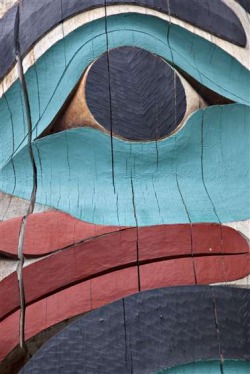 Totem Pole Detail, Anchorage Robert Capa, the famous 20th Century photojournalist and war photographer, once said "if your pictures aren't good enough, you aren't close enough." The only combat most of us will see is fighting our way through a buffet line on our favourite cruise ship, but the principle still applies today. Often our first impulse as photographers is to take that wide, establishing shot to remember where we were or prove to our friends and relatives that we went on vacation. Some photographers, for some inexplicable reason, need a shot of themselves in the image - here is me in front of the Eiffel Tower, here is me at the Louvre, here is me in front of Notre Dame. Just try getting an unobstructed close-up of the Little Mermaid in Copenhagen without everyone's aunt and uncle in the photo. I eventually gave up trying for a clear shot and now have a photo of the Little Mermaid with a wonderful, extended Turkish family in the foreground. By all means, take the establishing shot and the shot with your family in it, but stop and look for the details in the image as well. By moving in close, you'll capture the detail and texture of the subject that you often miss in the wide shot. You'll also reduce or eliminate any distracting background elements that may creep in. The photo to the right is of a totem pole in front of the Alaska Court System Building in Anchorage. The establishing shot includes the entire totem pole as well as the interesting yet distracting court building. Getting in close gives the viewer a chance to focus on the colours and shapes of the totem pole and to sense the texture of the wood. I am sometimes asked "how close is too close?" The answer I always give is the old adage - move in until you think something is missing from the picture, then move back a step. Give this a try - get in the habit of taking a close-up for every wide shot. At the end of your trip, look at your pictures side by side and ask yourself which are the more compelling images? You may surprise yourself with the answer! 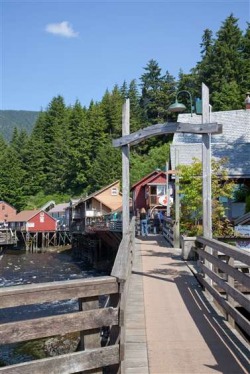 Creek Street, Ketchikan Sitka was founded because of the sea otter fur trade. Skagway started because of the Klondike Gold Rush. Ketchikan came into existence because of salmon. In 1883, a man by the name of Snow set up a salmon saltery near present day downtown Ketchikan. Soon after, a cannery was set up on the Ketchikan River and was followed by the stores and homes needed to support the developing town. Ketchikan is located on the western shore of Revillagigedo Island at the southern extreme of the Alaskan panhandle. The Tongass Narrows is the channel cruise ships take into and out of Ketchikan and separates the town from its international airport on Gravina Island. Why isn't there a bridge joining Ketchikan to its airport? Well, funding was set aside for a bridge until someone called it the "Bridge to Nowhere" and now there won't be any bridge at all. Ketchikan is rich in totem poles. Visits to Totem Bight State Park, Saxman Village, Potlatch Totem Park, the Totem Heritage Center, or even Whale Park in downtown Ketchikan will give you plenty of opportunities to view and photograph totem poles up close. Given the origins of the town, it is small wonder that fishing charters are quite popular here and that many cruise passengers use this port to try their luck catching a salmon or two. If you would rather stay on shore, there is shopping galore in the compact downtown core. A short distance beyond downtown - and well worth the walk - is Creek Street, where today small shops ply their business where bars and brothels like Dolly's House used to stand. Ketchikan has a great hardware/souvenir shop/grocery store right at the pier where savvy cruise passengers pick up water, soda and snacks to haul back on board ship. Try to make the Tongass Trading Company on the pier one of your last stops. This port is a great introduction to Alaska if it is your first port of call and an even better place to do the things you still haven't done if it is your last stop. Be prepared for the rain that falls very regularly in Ketchikan, but get out and enjoy yourself in this wonderful port of call. |
Dougall Photography
Blog Archives
June 2018
Blog Categories
All
|

 RSS Feed
RSS Feed
